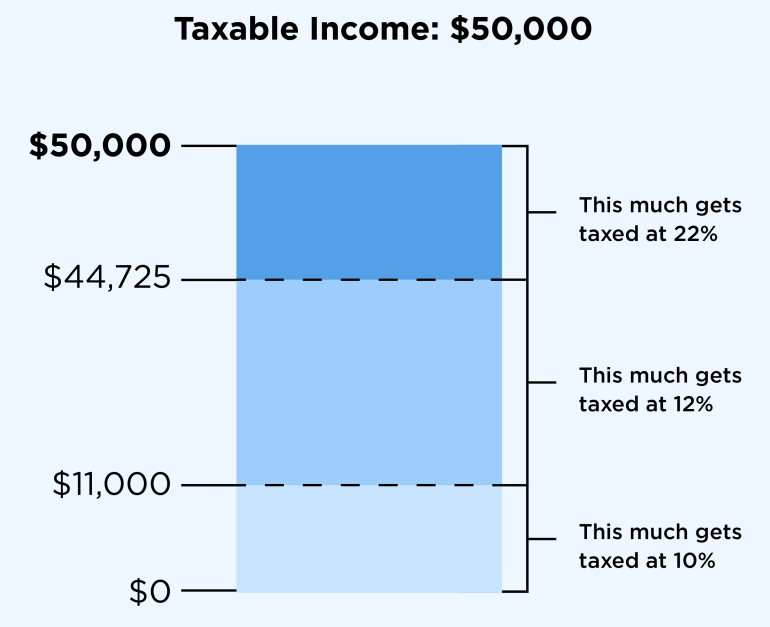There are seven federal income tax rates in 2023 and 2024: 10%, 12%, 22%, 24%, 32%, 35% and 37%. Your taxable income and filing status determine which rates apply to you.
The U.S. federal tax rates will remain the same until 2025 as a result of the Tax Cuts and Jobs Act of 2017, but the income thresholds that inform the tax brackets are generally adjusted each year to reflect the rate of inflation.
These adjustments can help prevent taxpayers from ending up in a higher tax bracket as their cost of living rises, often called “bracket creep.” The tax bracket adjustments can also lower taxes for those whose compensation has not kept up with inflation.
Get ready for simple tax filing with a $50 flat fee for every scenario
Powered by
Don’t miss out during the 2024 tax season. Register for a NerdWallet account to gain access to a tax product powered by Column Tax for a flat rate of $50 in 2024, credit score tracking, personalized recommendations, timely alerts, and more.
for a NerdWallet account
Tax brackets 2023 (taxes due April 15, 2024)
|
Married filing separately |
||||
|---|---|---|---|---|
Federal income tax returns for 2023 are due by April 15, 2024, or October 15, 2024, with a tax extension. There are seven tax rates: 10%, 12%, 22%, 24%, 32%, 35% and 37%.
The income thresholds for the 2023 tax brackets were adjusted significantly — up about 7% — from 2022 due to record-high inflation. This means that some people might be in a lower tax bracket than they were previously. Learn more about the 2023 tax rates and taxes owed for each status across taxable income brackets below:
2023 tax brackets: single filers
2023 tax brackets: married filing jointly
2023 tax brackets: married filing separately
2023 tax brackets: head of household
2024 tax brackets and federal income tax rates
Tax brackets 2024 (taxes due April 2025)
|
Married filing separately |
||||
|---|---|---|---|---|
The IRS recently released updated 2024 tax brackets that can help you plan ahead for 2025.
Each 2024 tax bracket will see a roughly 5.4% shift upward from 2023, which means taxpayers whose salaries haven’t kept up with inflation might be able to shelter more income from higher tax rates next year. The 2024 tax rates, which range from 10% to 37%, remain the same as in previous years.
Learn more about the 2024 tax rates and taxes owed for each status across taxable income brackets:
2024 tax brackets: single filers
2024 tax brackets: married filing jointly
2024 tax brackets: married filing separately
2024 tax brackets: head of household
How income tax brackets work
1. Federal income tax rates are progressive
The U.S. has a progressive tax system. Broadly, this means that the government decides how much tax you owe by dividing your taxable income into chunks — also known as tax brackets — and each chunk gets taxed at the corresponding tax rate. The highest tax rate, the marginal rate, applies to only a portion of your income.
The progressive tax system also means that people with higher taxable incomes are subject to higher federal income tax rates, and people with lower taxable incomes are subject to lower federal income tax rates. The beauty of tax brackets is that no matter which bracket you’re in, you won’t pay that tax rate on your entire income.
Example: If you had $50,000 of taxable income, you’d pay 10% on that first $11,000 and 12% on the chunk of income between $11,001 and $44,725. And then you’d pay 22% on the rest because some of your $50,000 of taxable income falls into the 22% tax bracket. The total bill would be about $6,300 — about 13% of your taxable income, even though you’re in the 22% bracket. That 13% is your effective tax rate.
2. State income taxes may work differently than federal income taxes
States may handle taxes differently than the federal government. Your state might have different brackets, or it might altogether use a different system. Colorado, for example, levies a flat income tax rate of 4.4% on taxable income, and some states, such as Wyoming, don’t levy a state income tax at all.
What is a marginal tax rate?
The marginal tax rate is the tax rate paid on your last dollar of taxable income. This typically equates to your highest tax bracket.
For example, if you’re a single filer in 2023 with $35,000 of taxable income, you would be in the 12% tax bracket. If your taxable income went up by $1, you would pay 12% on that extra dollar, too.
If you had $45,000 of taxable income, however, most of it would still fall within the 12% bracket, but the last few hundred dollars would land in the 22% tax bracket. Your marginal tax rate would then be 22%.
What is an effective tax rate?
The percentage of your taxable income that you pay in taxes is called your effective tax rate. To determine your effective tax rate, divide your total tax owed (line 16) on Form 1040 by your total taxable income (line 15).
Two common ways of reducing your tax bill are credits and deductions.
-
Tax credits can reduce your tax bill on a dollar-for-dollar basis; they don’t affect what bracket you’re in.
-
Tax deductions, on the other hand, reduce how much of your income is subject to taxes. Generally, deductions lower your taxable income by the percentage of your highest federal income tax bracket. So if you fall into the 22% tax bracket, a $1,000 deduction could save you $220.
In other words: Take all the tax deductions you can claim — they can reduce your taxable income and could kick you to a lower bracket, which means you pay a lower tax rate.
Get ready for simple tax filing with a $50 flat fee for every scenario
Powered by
Don’t miss out during the 2024 tax season. Register for a NerdWallet account to gain access to a tax product powered by Column Tax for a flat rate of $50 in 2024, credit score tracking, personalized recommendations, timely alerts, and more.
for a NerdWallet account
Tax brackets and rates for 2012-2022
Curious how federal income tax brackets and rates have changed over the years? Take a look back.
2022 tax brackets and rates
2021 tax brackets and rates
2020 tax brackets and rates
2019 tax brackets and rates
2018 tax brackets and rates
2017 tax brackets and rates
2016 tax brackets and rates
2015 tax brackets and rates
2014 tax brackets and rates
2013 tax brackets and rates
2012 tax brackets and rates





